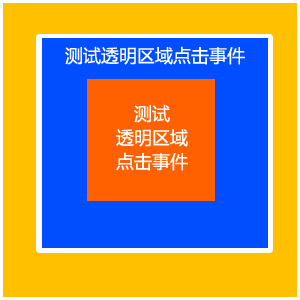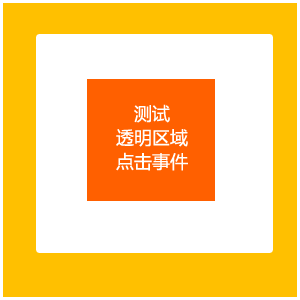经常用到多个透明图片层叠,但又需要获取不同图片的点击事件,本文实现图片透明区域穿透点击事件。
效果图:

欢迎转载请说明转自:http://blog.csdn.net/aminfo/article/details/7872748
一、先上图片,这2张图片尺寸是一样的,放到drawable目录下:
图1:transparent.png

图2:transparent2.png

二、上布局文件,test.xml:
<?xml version="1.0" encoding="utf-8"?>
<FrameLayout xmlns:android="http://schemas.android.com/apk/res/android"
android:layout_width="fill_parent"
android:layout_height="fill_parent"
android:orientation="vertical"
android:gravity="center"
android:id="@+id/mainLayout">
<ImageView android:id="@+id/ImageView01"
android:layout_width="wrap_content"
android:layout_height="wrap_content"
android:src="@drawable/transparent"/>
<ImageView android:id="@+id/ImageView02"
android:layout_width="wrap_content"
android:layout_height="wrap_content"
android:src="@drawable/transparent2"/>
</FrameLayout>
package org.shuxiang.test;
import android.app.Activity;
import android.graphics.Bitmap;
import android.graphics.drawable.BitmapDrawable;
import android.os.Bundle;
import android.util.Log;
import android.view.MotionEvent;
import android.view.View;
import android.view.Window;
import android.view.View.OnClickListener;
import android.view.View.OnTouchListener;
import android.widget.ImageView;
public class MainActivity extends Activity
{
private ImageView iv1;
private ImageView iv2;
private Bitmap bitmap1, bitmap2;
private boolean iv1Transparent = false;
private boolean iv2Transparent = false;
@Override
public void onCreate(Bundle savedInstanceState) {
super.onCreate(savedInstanceState);
requestWindowFeature(Window.FEATURE_NO_TITLE);
setContentView(R.layout.test);
iv1 = (ImageView) findViewById(R.id.ImageView01);
iv2 = (ImageView) findViewById(R.id.ImageView02);
bitmap1 = ((BitmapDrawable) (iv1.getDrawable())).getBitmap();
bitmap2 = ((BitmapDrawable) (iv2.getDrawable())).getBitmap();
iv1.setOnClickListener(new OnClickListener(){
@Override
public void onClick(View v) {
// TODO Auto-generated method stub
if(iv1Transparent)
{
Log.i("test", "图1透明区域");
}
else
{
Log.i("test", "图1点击");
}
}
});
iv1.setOnTouchListener(new OnTouchListener()
{
@Override
public boolean onTouch(View arg0, MotionEvent arg1)
{
// TODO Auto-generated method stub
if(bitmap1.getPixel((int)(arg1.getX()),((int)arg1.getY()))==0)
{
Log.i("test", "图1透明区域");
iv1Transparent = true; //透明区域设置true
}
else
{
Log.i("test", "图1实体区域");
iv1Transparent = false;
}
return false;
}
});
iv2.setOnClickListener(new OnClickListener()
{
@Override
public void onClick(View v) {
// TODO Auto-generated method stub
if(iv2Transparent)
{
Log.i("test", "图2透明区域");
}
else
{
Log.i("test", "图2点击");
}
}
});
iv2.setOnTouchListener(new OnTouchListener()
{
@Override
public boolean onTouch(View v, MotionEvent event) {
// TODO Auto-generated method stub
if(bitmap2.getPixel((int)(event.getX()),((int)event.getY()))==0)
{
Log.i("test", "图2透明区域");
iv2Transparent = true; //透明区域设置true
iv1.dispatchTouchEvent(event);
}
else
{
Log.i("test", "图2实体区域");
iv2Transparent = false;
}
return false;
}
});
}
}